COMMERCIAL MOTORS AT OLYMPIA.
Page 12

Page 13
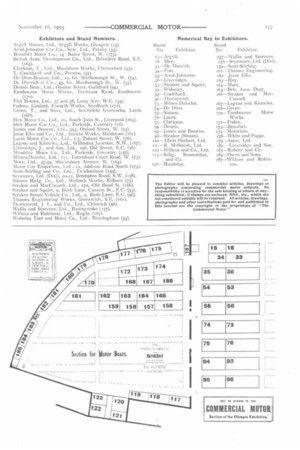
Page 14
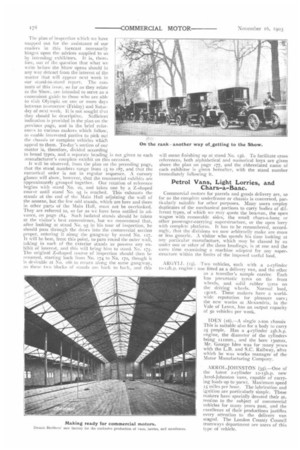
Page 16
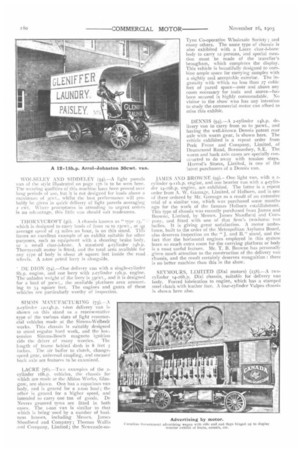
Page 17
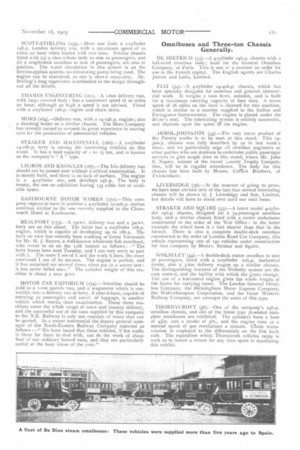
Page 18

Page 20
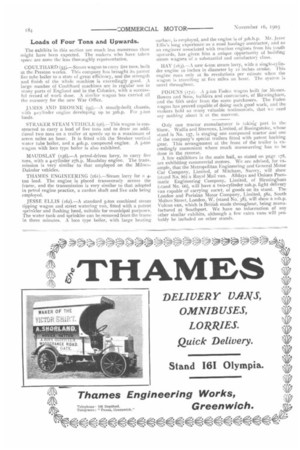
Page 21
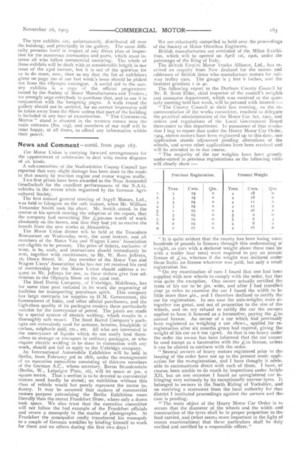
If you've noticed an error in this article please click here to report it so we can fix it.
What to See—What Must Not be Missed.
By the Editor.
7-10-m4m-row (Friday) will witntee, the .opening of the fourth Annual Exhibition of the Society of Motor Manufacturers and Traders at Olympia. We introduced the subject of the commercial motor section .00 our readers a fortnight ago, and that brief anticipation was followed, last week, by :I forecast of the various exhibitors sufli.cient to prove how important a place the forthcoming Show must take in the pages of TtiF. COMMERCIAL MOTOR." The structural changes, which have occupied The close attention of the Society during the past six months, have been carried Out to the hnmediate satisfaction of all parties, though the question of further space for the ever-growing ranks of newcomers to the industry may, for aught we can see, be settled much on the lines that are claimed by ardent motorists in regard to the solution of street congestion —by making bettet use of the space that is available.
There is little to cavil at in the location of the building, for it is oomparatively
ready of access from all quarters. Addison Road Station, with a covered passage to afford shelter should the weather he inclement, adjoins the main entrance, and it is served from ail points of London. Frequent trains run ftom Willesden and Clapham Junctions, whilst the half-hourly L. and N.W. trains between Broad Street and the Mansion House, and vice versa, will be a convenience to the thousands who can best get to the exhibition by joining them at any station between the City and Gloucester Road, to the south, or on the Dalston-Camden Town-Hampstead Heath line, to the north. It might also be mentioned that the two Hammersmith Stations are little more than a half-mile from the pay gates. The tube (Central London Railway) is another means of conveyance, the completion of the journey from Shepherd's Bush Station being, at choice of the traveller —(a) train from Uxbridge Road Station (So yards to west of tube terminus) to Addison Road Station; (b) omnibus starting from corner of road facing Uxbridge Road Station; or (c) hansomlegal fare one shilling.
Motor omnibuses should, where possible, be patronised to the exclusion of all other systems. The tube line has a splendid service of these vehicles above tile length from Oxford Circus to Shepherd's Bush, and 'beyond to Hammersmith : all who go by these omnibuses should alight opposite Uxbridge Road Station by preference. There is every likelihood, too, that the more direct service from Piccadilly Circus will be greatly augmented on all days from the 17th to 25th instant inclusive, and nothing can equal this route in point of the small time occupied. .
We now begin our self-imposed task of telling our readers what to see at Olympia. There is no rule against an inspection of each individual exhibit without exception, and it is far from our intention to deter anybody from a systematic trudge here, there, and everywhere, at his own sweet will. Ten o'clock in the morning till ten o'clock at night, for, let us say, at least three days, may appeal to some who study these pages. They will probably choose to rely on themselves rather than on our assistance : we wish them joy of their sensations and impressions when it is all accomplished. May confusion be not worse confounded in their heads.
To the busy man, who will decide to. snatch a few hours from his London office and other multifarious duties, we address ourself, more than to the man who can take a week off and go round the Show at his leisure. His point of view is how little need I look at, rather than how much can I see, True. Ti is exactly that attitude of mind we appreciate. Our raison d'otre is to place in the hands of such men the means to an end; to render it possible for them to pick out from our scheme of reference that which interests them ; to enable them, in short, to take a quick decision in the knowledge that they have not seen everything and have yet missed nothing! We do not profess to advance the whole case for or against different types of commercial motors. We have been doing that, step by step, for close on nine months, aod we know that the stand-holders have their arguments and testimonials ready. To-day's references to the Show are prefatory to our own stand-to-stand examination, but what we write is based on a full knowledge of various performances on the road. No criterion is more exacting than this standard of working conditions, and no comment founded on such records can rightfully yield to unsupported theory. We advise all who go to Olympia to have no hestitation to place orders : they can free their minds front the idea that commercial motoring is a new phase of the automobile movement. It is, on the contrary, older than the purely pleasure side, but its lesser attractiveness accounts for its smaller prominence in the Press. Business vehicles have to he at least self-supporting, whilst the ordinary motorcar is expected to be a source of expense to its owner except where used professionally. Exhibitors and Stand Numbers.
Argyll Motors, Ltd., Argyll Works, Glasgow (15). Arrol-Johnston Car Co., New, Ltd., Paisley (35).
Beaufort Motor Co., 14 Baker Street, \V. (i73), British Auto. Development Co., Ltd., Belvedere Road, S.E. (r65).
Clarkson, 'F., 1..td., MooIsharn Works, Chelmsford (93). T. Coultherd and Co., Preston (55).
De Dion-Bouton, Ltd., ro, Gt. Marlborough Sc., V. (74). De Dietrich et Cie., 45, tit. Marlborough St., W. Dennis Bros., Ltd., Onslow Street, Guildford (94). Eastbourne Motor Works, Terininus Road, Eastbourne (r7o). Fiat Motors, Ltd., 37 and 38, Long Acre, W.C. (34). Fodens, Limited, Elworth Works, Sandbach (172).
Green, T., and -Sons, Ltd., Smithfield Ironworks, Leeds
(x68).
Hay Motor Co., Ltd., 20, South John St., Liverpool (163). Hen Motor Car Co., Ltd., Parkside, Coventry (16). James and Browne, Ltd., 395, Oxford Street, W. (95). Jesse Ellis and Co., Ltd., Invicta Works, Maidstone (162). Lacre Motor Car Co., Ltd., 7-5, Poland Street, W. (76). Legros and Knowles, Lid., Willesden Junction, N.W. (167). Liversidge, J., and Son, Ltd., /96, Old Street, E.C. (36). Maudslay Motor Co., Ltd., Parkside, Coventry (156). Milnes-Daimler, Ltd., 221, Tottenham Court Road, W. (73). 1.Iors, Ltd., 55-59, Shaitesbury Avenue, W. (164). Motor Car Emporium, I.td., ra, Addison Road North (174). Scott-Stirling and Co., Ltd., Twickenhain (159). Seymours, Ltd. (Dixi), 20-22, Brompton Road, S.W. (158). Simms Mnig. Co., Ltd., Welbeck Works, Kilburn (75). Straker and MacConnell, Ltd., 27a, Old Bond St. (166). Straker and Squire, 9, Bush Lane, Cannon St., E.C. (53). Straker Steam Vehicle Co., Ltd., 9, Bush Lane, E.C. (96). Thames Engineering Works, Greenwich, S. F. (161). Th3rnycroft, J. I., and Co., Ltd., Chiswick (56).
Wallis and Steevens, Lid., Basingstoke (r57).
Willans and Robinson, Ltd., Rugby (187). Wolseley Tool and Motor Co., Ltd., 'Birmingham (54). The plan of inspection which we have mapped out for the assistance of our readers in this forecast necessarily hinges upon the advices supplied to us
by intending exhibitors. It is, therefore, out of the question that what we write before the Show opens should in any way detract from the interest of the matter that will appear next week in our stand-to-stand report. The contents of this issue, so far as they relate to the Show, are intended to serve as a convenient guide to those who are able to visit Olympia on one or more days between to-morrow (Friday) and Saturday of next week. It is not sought tlett they should be descriptive. Sufficient indication is provided in the plan, on the previous page, and in the brief references to various makers which follow, to enable interested parties to pick out
the chassis or complete vehicles which appeal to them. To-day's section of our matter is, therefore, divided according to broad types, and a separate heading is not given to each manufacturer's complete exhibit on this occasion.
It will be observed, from the plan on the preceding page, that the stand numbers range from 15 to 187, and that the numerical order is not in regular sequence. A cursory glance will show, however, that the commercial exhibits are approximately grouped together. Our rotation of reference begins with stand No. to, and takes one by a Z-shaped course until stand No. 95 is reached. This exhausts the stands at the end of the Main Hall adjoining the wall of the annexe, but the few odd stands, which are here and there in other parts of the Main Hall, must not be overlooked. They are referred to, so far as we have been notified in advance, on page 184. Such isolated stands should be taken at the visitor's best convenience, but we recommend that, after looking at stand No. 95 in his tour of inspection, he should pass through the doors into the commercial section proper, entering it along the gangway by stand No. 117. It will be best, from this point, to pass round the outer wall, taking in such of the exterior stands as possess any exhibit of interest, and this will bring him to staial No. 175. The original Z-shaped course of inspection should then be resumed, starting back from No. 174 to No. 170, though it is desirable at No. 166 to return along the same gangway, as these two blocks of stands are hark to back, and this
will mean finishing up at stand No. 156. To facilitate cross references, both alphabetical and numerical keys are given above the plan on page 177, and the abbreviated name of each exhibitor is given hereafter, with the stand number immediately following it.
Petrol Vans, Light Lorries, and Chars-a-Bane.
Commercial motors for parcels and goods delivery are, so far as the complete underframe or chassis is concerned, particularly suitable for other purposes. Many users employ duplicates of the mechanical portions to carry bodies of different types, of which we may quote the box-van, the open wagon with removable sides, the small chars-a-bane or other passenger-carrying superstructure, or the open lorry with complete platform. It has to be remembered, accordingly, that the divisions we now arbitrarily make are more or less generic. A visitor who spends his time looking at any particular manufacture, which may be classed by us under one or other of the three headings, is at one and the same time examining a machine adapted for any superstructure within the limits of the imposed useful load.
ARGYLL (r5). Two vehicles, each with a 2-cylinder to-1211.p. engine : one fitted as a delivery van, and the other as a traveller's sample carrier. Each has pneumatic tyres on the front wheels, and solid rubber tyres on the driving wheels. Normal load, iscwt. These makers have a worldwide reputation for pleasure cars; the new works at Alexandria, in the Vale of Leven, has an output capacity of so vehicles per week.
'MEN (x6).--A single 2-ton chassis This is suitable also for a body to carry 25 people. Has a 4-cylinder 25b.h.p. engine, the diameter of the cylinders being itimm., and the bore I 3omm. Mr. George Iden was for many years with the L.B. and S.C. Railway, after which he was works manager of the Motor Manufacturing Company.
ARROL-JOHNSTON (35).—One of the latest 2-cylinder 12-15lep. new Arrol-Johnston vans, capable of carrying loads up to 3ocwt. Maximum speed 15 miles per hour. The lubrication and ignition are particularly simple. These makers have specially devoted their attention to the subject of commercial vehicles for many years past, and the excellence of their productions justifies every attention to the delivery van staged. The London County Council. tramways department are users of this type of vehicle. WOLSELEY AND SIDDELEY (54).----A light parcels van of the sts le illustrated on page 176 is to be seen here. The wearing qualities of this machine have been proved over long periods of use, but it is not designed for loads above a maximum of ;cwt., whilst the best performance will probably be given in quick delivery of light parcels averaging 2 cwt. Where promptness in attending to urgent orders is an advantage, this little van should suit tradesmen.
THORNYCROFT (56). A chassis known as " type 25." which is designed to carry loads of from TO TO 250%1,, at zip average speed of 15 miles an hour, is on this stand. Tht's forms an excellent example of an exhibit suitable for other purposes, such as equipment with a shooting brake body, or a small char-a-bane. A standard, 4-cylinder 24h.p. Thornycroft motor is fitted, and the total area available for arty type of body is about 2g square feet inside the road Wheels. A 2-ton petrol lorry is alongside.
DE DION (74).—One delivery van with a single-cylinder Sh.p. engine, and one lorry with 2-cylinder 12h.p. engine. The unladen weight of the lorry is 35cwt., and it is designed for a load of 3ocwl., the available platform area amounting to 34 square feet, The engines and gears of these vehicles are particularly worthy of inspection.
SIMMS MANUFACTURING (75).—A 2-cylinder 12-14h.p. t-ton delivery van is shown on this stand as a representative type of the various sizes of light rammercial vehicles made at the Simms-Welbeek works. This chassis is suitably designed to stand regular hard work, and the lowtension Simms-Bosch magneto ignition rids the driver of many worries. The length of frame behind dash is 8 feet 3 inches. The air buffer to clutch, change!speed gear, universal coupling, and encased hack axle are features to be examined.
LACRE (76).—Two examples of the 2cylinder t6h.p. vehicles, the chassis for which are made at the Albion Works, Glasgow, are shown. One has a capacious van body, and is geared for a 2-ton load; the other is geared for a higher speed, and intended to carry one ton of goods. De Nevers grooved tyres are fitted in both -cases. The I-ton van is similar to that which is being used by a number of business houses, including Messrs. James :Shoolbred and Company; Thomas Wallis .and Company, Limited; the Newcastle-on 'Fyne Co-operative Wholesale Society ; and many others. The same type of chassis is also exhibited with a Lacre char-a-bane body to carry 12 persons, and special mention must be made of the traveller's brougham, which completes the display. This vehicle is beautifully designed to combine ample space for carrying samples with a sightly and acceptable exterior. The ingenuity with which no less than 27 cubic feet of parcel space—over and above any room necessary for tools and stores—has been secured is highly commendable. No visitor to the show wno has any intention to study the commercial motor can afford to miss this exhibit.
DENNIS (94).—A 2-cylinder 1411,p. delivery van to carry from 20 to 3ocwt., and having the well-known Dennis patent rear axle with worm gear, is shown here. The vehicle exhibited is a repeat order from Peek Erean and Company, Limited, of Drummond Road, Bermondsey, S.E. The worm and back axle cases are specially constructed to do away with tension stays. Harrod's Stores, Limited, is one of the latest purchasers of a Dennis van.
JAMES AND BROWNE (95).One light van, with a 2cylinder 9-1111.p. engine, and one heavier van with a 4-cylinder 14-16h.p. engine, are exhibited. The latter is a repeat order from A. W. Gamage, Limited, of Holborn, and is one of three ordered by Mr. Carnage as a result of an extensive trial of a similar. van, which was purchased some months ago for the work of the famous .11olborn establishment.. This type of chassis was recently purchased from James and Browne, Limited, by Messrs. James Shoolbred and Company, and fitted with one of that firm's two-horse van bodies. Tt is giving great satisfaction. A motor ambulance, built to the order of the Metropolitan Asylums Board, also deserves inspection on the " J. and 13." stand, and the fact that the horizontal engines employed in this system leave so much extra room for the carrying platform or body is a most useful feature. Mr. T. B. Browne has personally given much attention to the construction of the delivery van chassis, and the result certainly deserves recognition : there is no better machine than this in the show.
SEYMOURS, LIMITED (Dixi motors) (158).—A twocylinder 14-16h.p. Dixi chassis, suitable for delivery van body, Forced lubrication to engine, which has a stamped steel clutch with leather face. A four-cylinder Vulpes chassis is shown here also. SCOTT-STIRLING (159).—Here one finds a 2-cylinder t4h.p. London delivery van, with a maximum speed of to miles an hour when loaded with two tons. Similar chassis fitted with (a) a char-à-banc body to seat 22 passengers, and (b) a single-deck omnibus to seat 18 passengers, are also in position. The water circulation in this system is on the thermo-syphon system, no circulating pump being used. The engine can be examined, as one is show n septuateiy. Mr. Stirling's long experience is embodied in the design throughout all the details.
THAMES ENGINEERING (161). A t-ton delivery van, with large covered body : has a maximum speed of 20 miles an hour, although so high a speed is not advised. Fitted with a 2-cylinder 12h.p. engine and chain drive.
MORS (164).—Delivery van, with a 14-19h.p. engine; also a shooting brake on a similar chassis. The Mors Company has recently turned to account its great experience in touring cars for the production of commercial vehicles.
STRAKER AND MACCONN ELL (t66).—A 2-cylinder 14-16h.p. lorry is among the interesting exhibits on this stand. It has a load capacity of i to i ton, and is known as the company's " A " type.
LEGROS AND KNOWLES (167).—The Iris delivery van should not be passed over without a critical examination. It is stoutly built, and there is no lack of surface. The engine is a 4-cylinder one, and develops 2411.p. The body is roomy, the one on exhibition having 135 cubic feet of available space.
EASTBOURNE MOTOR WORKS (17o).—This corn. pany expects to have in position a 4-cylinder to-2oh.p. station omnibus similar to the one recently supplied to the Chatsworth Hotel at Eastbourne.
BEAUFORT (173).—A iscwt. delivery van and a 3ocwt. lorry are on this stand. The latter has a 2-cylinder 12h.p. engine, which is capable of developing up to 18h.p. The lorry on view has recently been working at Great Yarmouth for Mr. H. J. Sayers, a well-known wholesale fish merchant, who wrote to us on the 12th instant as follows : --" The lorry leaves here next Tuesday, and I ant very sorry to part with it. The more I see of it and the work it does, the more convinced I am of its success. The engine is perfect, and it has surprised me several times when put to a severe test : it has never failed once." The unladen weight of this machine is about 2 tons scwt.
MOTOR CAR EMPORIUM (174).—Attention should be paid to a i-ron parcels van, and a wagonette which is convertible into a delivery van or lorry. A char-A-bane, capable of carrying 20 passengers and tocwt. of luggage, is another vehicle which merits close examination. These three machines cover the whole range of town and country delivery, and the successful use of the vans supplied by this company to the N.E. Railway is only one example of many that can he quoted. In a recent testimonial the deputy general manager of the North-Eastern Railway Company reported as follows :—" We have found that these vehicles, if the traffic is there for them to deal with, can do the work of about four of our ordinary horsed vans, and they are particularly useful at the busy times of the year."
Omnibuses and Three-ton Chassis Generally.
DE DIETRICH (33).—A 4-cylinder 2411.p. chassis with a full-sized omnibus uody ; built for the General Omnibus Company, of Paris. This is one of a number on order for use in the trench capital. The English agents are Charles jarrott and Letts, Limited.
FIAT (34).—A 4-cylinder 24-4oh.p. chassis, which has been specially designed for omnibus and general commercial work. It weighs 2 1011S &wt. unladen, and is built for a maximum carrying capacity of four tons. A mean speed of 18 miles on the level is claimed for this machine, which is similar to a number supplied to the Italian and Portuguese Governments. The engine is placed under the driver's seat. The lubricating system is entirely automatic, and depends upon the speen 61 the engine.
ARROL-JOHNSTON (35).—The very latest product of the Paisley works is to be seen at this stand. This 243oia.p. chassis was fully described by us in last week's issue, and we particularly urge all omnibus engineers or other parties who are desirous to undertake public passenger services to give ample time to this stand, where Mr. John S. Napier, winner of the recent ' LIVERS1DGE (36).—At the moment of going to press, we have been advised only of the fact that several interesting chassis will be shown by J. Liversidge and Son, limited, but details will have to stand over until our next issue. STRAKER AND SQUIRE (53).—A latest model 4-cylinder 24h.p. chassis, designed for a 34-passenger omnibus body, and a similar chassis fitted with a motor ambulance constructed to the order of the War Office :. in the latter example the wheel base is 2 feet shorter than that in the former. There is also a complete double-deck omnibus constructed to the order of London Road Car Company, this vehicle representing one of 140 vehicles under construction for that company by Messrs. Straker and Squire. WOLSELEY (54).--A double-deck motor omnibus to seat 36 passengers, fitted with a 2-cylinder 2oh.p. horizontal motor, also a 3-ton delivery wagon on a similar chassis. The distinguishing features of the Wolseley system are the easy control, and the facility with which the gears change. The use of a horizontal engine gives the whole length of the frame for carrying room. The London General Omnibus Company, the Birmingham Motor Express Company, the Wolverhampton Corporation, and the Great Western Railway Company, are amongst the users of this type. THORNYCROFT (56).—One of the company's 24h.p. omnibus chassis, and one of the latest type 36-seated complete omnibuses are exhibited. The cylinders have a bore of 41in, and a stroke of 5in., and the engine runs at a normal speed of 900 revolutions a minute. Chain transmission is employed to the differentials on the live back axle. The reputation which Thornycroft vehicles enjoy is such as to insure a return for any time spent in examining this exhibit. MILNES-DAIMLER (73).—The very latest double-deck omnibus built to the order of Thomas Tilling, Limited, will be exhibited here; also a single-deck private omnibus built to the order of Sir Ernest Cassel. The former has a 4-cylinder 28.30h.p. motor, with all improvements, including provision to drop the lower half of the crank chamber, so that the big end hearings can be got out without having fo dismantle the whole of the engine, as is the case in the earlier types. The body for the private bus, which has a 4-cylinder iSh.p. engine, has been built by Mr. C. Dodson, of 45, Horse/erre, Road, Westminster. There is also here a standard double-deck omnibus, built to the order of the L. and N.W. Railway. Mr. H. G. Burford, the managing director of MiInes-Daimler, Limited, who is the pioneer and " father " of the motor-omnibus movement in England, 1v ill he ready to afford any information, although his delivery date is so far ahead that it will be of no interest to many. DE DION (74).—A 20-seated char-it-banes, with a 4-cylinder 24-3oh.p. engine. The engine and transmission is similar to the type of a very large number which have been ordered for London omnibus companies. SIMMS (75).—A 4-cylinder 28-3411.p. chassis, together with a complete bus. The cylinders have a bore of 120mm. and a stroke of 135mm., being cast in pairs. Simms-Bosch low-tension magneto is fitted. This chassis embodies many important features in design, Which have been introduced by Mr. Frederick R. Simms. CLARKSON (93).—A latest type chassis, for a doubledeck omnibus body, as supplied to the London Road Car Company, Limited, fitted with the Clarkson automatic generator and patent paraffin burner. Mr. Clarkson will be happy to explain the improvements he has recently made in the double-deck type of chassis, and it is satisfactory to know that this latest production of the Chelmsford works is giving so great satisfaction. The smoothness of running, the quick acceleration, the absence of odour, and the freedom from jars or jerks (by reason of there being no changespeed gear), render the steam omnibus a very attractive preposition, especially in crowded cities. DENNIS (94).A double-deck omnibus fitted with the Dennie 4-cylinder 24h,p. engine. This vehicle will be delivered to Thomas Tilling, Limited, cf Peckham, iinmediately after the Show, for trial purposes. Two similar chassis are exhibited, one being geared as a 3-ton lorry, and the other as a delivery van capable of carrying fully two tons. In this system the direct drive in the top gear and the arrangement of the worm on the back axle are perticularly interesting. JAMES AND BROWNE. (95).—This company has recently completed a most promising 5-ton chassis suitable for an omnibus. It is fitted with a 4-cylinder 25-3oh.p. horizontal motor, and the transmission is one of several interesting features with which we shall have to deal fully next week. The vehicle is fitted with Royal Sirdar Buffer tyres, and it will be noticed that the overhang at the back is reduced to a minimum, practically the whole of the weight coming inside the wheel base. The same chassis may be fitted with a 2o-22h.p. engine, which the makers think ample for many purposes. The wearing surfaces of this car and the lubrication system employed on the engine, are well suited for public service work. MAUDSLAY (i56).—A double-deck omnibus chassis is exhibited, and the body eo fit it. The engine is of the 4-cylinder 3o-4oh.p. type, with some of the parts strengthened for public service work. It is chain driven, 201. pitch roller chains being employed. The "gate" system of change-speed lever is adopted, and metal-to-metal locomotive type brakes are used on the vehicle, which is of very strong build throughout. SCOTT-STIRLING (159).---A double-deck omnibus, with a 24h.p. chassis, is shown. This has been built to the order of the London Power Omnibus Co., Ltd., being one of too vehicles on order for that company, whose management have agreed to a later delivery date in order to take all their order in the double-deck type. This system has been worked out by Mr. John Stirling, as the outcome of ten years' ex perience in public service work, and that experience has been gathered both in the country and in populous towns. THAMES ENGINEERING (161).—This company is bringing forward a chassis suitable for motor omnibus work. It is on the same lines as their van chassis, and is designed to carry a 36-passenger body. The 4-cylinder engine develops front 24 to 3oh.p., and the maximum speed is 14 miles per hour under full load. MORS (164).—The exhibit is limited to a double-deck omnibus, with a passenger-carrying capacity of 36 seats. This vehicle will shortly be on the streets of London. It is tilted with a 4-cylinder 24-32h.p. engine, and is a duplicate of the vehicle which gave such excellent results in the recent trials of the French Automobile Club. BRITISH AUTOMOBILE DEVELOPMENT .(i6).-The omnibus illustrated on page 177 is shown, and this is one of a large number which will shortly he put in service as part of provincial and other omnibus undertakings. STRAKER AND MACCONNELL (166).---A selection of omnibuses is expected to arrive for inclusion on this stand, and it is announced that practically the whole of the vehicles shown will be new types in this country_ BEAUFORT (i73).—A chain-driven omnibus chassis, as built for this company for use in London, fitted with a 4-cylinder 24-3oh.p. engine, deserves close inspection. MOTOR CAR EMPORIUM (174). This stand will be a veritable Mecca for enquirers after motor omnibuses, as the Motor Car Emporium, Limited, has been most active in placing its orders for many hundreds of chassis of recognised and approved makes. The exhibit will include an observation car, which is one of a number supplied to the Great Western Railway Company, and another doubledeck omnibus, fitted with a canopy, of an entirely new and special design. The body of this last-named vehicle will seat no less than 41) passengers. The latest stand o be secured was No 187—by 1Villans and Robinson, Limited, of Rugby. This company has been allotted the space shown on our plan on page 177, and it is intended to show specimens of vanadium steel and other articles of interest to motorcar manufacturers. Samples of these steels were exhibited at, and commented upon in, the presidential address to the Automobile and Cycle Engineers' Institute, given by Mr. Alexander E. Tuc ker, which will be found in our issues of November 2nd, November 9th, and concluded in this number. The appended account of a special test run from Glasgow, in respect of one of the Lacre vans, is additional testimony to their worth. This reaches us just as we go to press : '1 have pleasure in reporting that we left Scotstoun, Glasgow, at 7 a.m. on Saturday, the iith November, arrived at Poland Street at two minutes past one o'clock p.m. on Sunday, November 12th. The van ran most satisfactorily throughout, and easily maintained an average speed of over 14 miles per hour, and, in fact, on two occasions only was the first speed used. The following are a few details with regard to the run :—(a) The complete distance travelled, taking into consideration a few detours, was 420 miles; (h) the petrol consumption was 27 gallons, which works out at 1,5i miles per gallon; and (c) three quarts of lubricating oil were consumed. I am happy to say the only stop to be recorded for other than traffic and accidental detours was one of 30 seconds, about five miles from Leeds, for the replacement of the fan belt which had jumped the pulley. The climb over the Shap was accomplished on the top and second speeds, a really good performance considering that the weight of the van (with three up and luggage) was over two tons. The weather conditions were exceptionally severe, it having rained 23 out of the 30 hours, the roads, therefore, being exceedingly heavy. " I shall be pleased to forward you a certificate in due course.—Yours faithfully, " (Signed) Jesixs R. NISBET, JR." Loads of Four Tons and Upwards. The exhibits in this section are much less numerous than might have been expected. The makers who have taken space are none the less thoroughly representative. COULTHARD (55).—Steam wagon to carry five tons, built at the Preston works. This company has brought its patent fire tube boiler to a state of great efficiency, and the strength and finish of the whole machine is exceedingly good. A large number of Coulthard machines are in regular use in many parts of England and in the Colonies, with a successful record of work done, A similar wa._,.;on has carried all the masonry for the new War Office. JAMES ANT) BROWNE (95).—A stoutly-built chassis, ‘vith 4-cylinder engine developing up to 30h.p. For 5-ton loads. STRAKER STEAM VEHICLE (96).—This wagon is constructed to carry a load of five bons and to draw an additional two tons on a trailer at speeds up to a maximum of seven miles an hour. It is fitted with the Straker vertical water tube boiler, and a 4oh.p. compound engine. A 5-ton wagon with loco type boiler is also exhibited. DifAUDSLAY (t56).—A petrol-driven lorry, to carry five tons, with a 4-cylinder 27h.p. Maudslay engine. The transmission is very similar to that employed on the MilnesDaimler vehicles. THAMES ENGINEERING (r6t).—Steam lorry for a 4ton load. The engine is placed transversely across the frame, and the transmission is very similar to that adopted in petrol engine practice, a cardan shaft and live axle being employed. JESSE ELLIS (162).—A standard 5-ton combined steam tipping wagon and street watering van, fitted with a patent sprinkler and flushing head, suitable for municipal purposes. The water tank and sprinkler can be removed from the frame in three minutes. A loco type boiler, with large heating surface, is employed, and the engine is of 3ob.h.p. Mr. Jesse Ellis's long experience as a road haulage contractor, and as an engineer associated with traction engines frmn his youth upwards, has given him a unique Opportunity of building steam wagons of a substantial and satisfactory class. HAY (163).—A new 6-ton steam lorry, with a single-cylinder engine to inches in diameter by 12 inches stroke. -Phis engine runs only at So revolutions per minute when the wagon is travelling at five miles an hour. The system is novel throughout. FODENS (i72). -A 5-ton Foden wagon built for Messrs. BOWell and Sons, builders and contractors, of Birmingham, and the fifth order from the same purchasers. The Foden wagon has proved capable of doing such good work, and the makers hold so many valuable testimonials, that we need say nothing about it at the moment. Only one tractor manufacturer is taking part in the Show. Wallis and Steevens, Limited, of Basingstoke, whose stand is No. 157, is staging one compound tractor and one of the company's special trailers fitted with patent backing gear. This arrangement at the front of the trailer is exceedingly convenient where much manomyring has to be done in the reverse. A few exhibitors in the main hall, as stated on page 178, are exhibiting commercial motors. We are advised, for example, that the Metropolitan Engineering and General Motor Car Company, Limited, of Mitcham, Surrey, will show (stand No. 86) a Royal Mail van. Alldays and Onions Pneumatic Engineering Company, Limited, of Birmingham (stand No. 66), will have a two-cylinder toh.p. light delivery van capable of carrying tocwt, of goods on its stand, The London and Parisian Motor Company, Limited, 58a, South MoRon Street, London, W. (stand No. 38), will show a mh.p. Vulcan van, which is British made throughout, being manufactured at Southport. We have no information of any other similar exhibits, although a few extra vans will probably be included on other stands. The tyre exhibits are, unfortunately, distributed all over the buhding, and principally in the gallery. The same difficulty presents itself in respect of any direct plan of inspection for the numerous accessories and parts, which must interest all who follow commercial motoring. The whole of these exhibits will be dealt with at considerable length in our issue of the 23rd instant, but it is out of the question for us to do more, now, than to say that the list of exhibitors given on page ibo of our last week's issue should be picked out from the Olympia catalogue. A useful aid to the sundry exhibits is a copy of the official programme issued by the Society of Motor Manufacturers and Traders; M.e strongly urge everybody to purchase that, and to use it in conjunction with the foregoing pages. A walk round the gallery should not be omitted, for no correct impression will be taken away from the Show unless that part of the building is included in any tour of examination. " Toe COMMERCIAL MOTOR " stand is situated in the western corner near the main entrance (No. toe), and members of our staff will he most happy, at all times, to afford any information within their power.
































